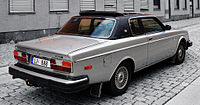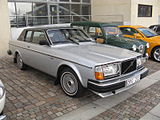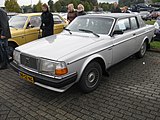Volvo 262 C.
| Volvo | |
|---|---|
|
Volvo 262 C (1976-1978)
|
|
| 262 C | |
| Production period: | 1976-1982 |
| Class : | upper middle class |
| Body versions : | Coupe |
| Engines: |
Petrol engines : 2.7–2.9 liters (103–114 kW) |
| Length: | 4900 mm |
| Width: | 1710 mm |
| Height: | 1340 mm |
| Wheelbase : | 2640 mm |
| Empty weight : | 1450 kg |
| successor | Volvo 780 |
The Volvo 262 C is a passenger car built by the Swedish car manufacturer Volvo from mid-1976 to early 1982 . It had no immediate predecessor, but is considered by some to be the successor to the Volvo P1800 ES called Snow White's coffin . As a target group, Volvo had primarily intended wealthy residents of the big cities on the North American east and west coast.
Development and manufacture
The designs for the 262 C came from Volvo's in-house designer Jan Wilsgaard . The Italian bodywork factory Bertone , to which the design is often attributed, had nothing to do with the design. Bertone only took over the series production of the vehicles.
The first prototype was made by Coggiola in Beinasco , Italy . A Volvo 164 served as the basis . Coggiola removed the rear doors and the standard roof; then a significantly lower roof with a shorter windshield was installed. This prototype still exists today. The findings from the conversion of that Volvo 164 were taken into account in the production of the 262 C by Bertone.
A total of 6,622 copies of the Volvo 262 C were built in the almost six years of construction.
Equipment and engine
The vehicles are assigned to the market segment of the upper middle class, although they were very extensive and lavishly equipped for their time. In addition to air conditioning, cruise control and heated seats, leather seats, root wood , electric windows and power steering were standard. A manual four-speed gearbox with overdrive and a three-speed automatic from BorgWarner were available as transmissions .
A six-cylinder injection engine was used as the engine. The machine known as the PRV engine was developed in cooperation with Peugeot and Renault and had been in use in the sedans and station wagons of the Volvo 260 series since summer 1974 .
When the 262 C was introduced in August 1976, the engine had an output of 103 kW (140 hp) from a displacement of 2.7 liters. In the following year, the output was increased to 109 kW (148 hp).
In the late summer of 1978, the Coupé 262 C, like the sedans 264, received a trunk lid that was pulled down and new rear lights that were visible from the side.
In the autumn of 1980, the coupé was again subjected to a facelift parallel to the other models in the 260 series. The fittings, headlights, indicators and bumpers were revised. The displacement was increased to 2.9 liters and the engine output increased to 114 kW (155 hp). The top speed was around 180 km / h.
In the first two years of production, the cars were exclusively delivered from the factory in silver metallic with a black vinyl roof . Gold metallic was also available from model year 1979. The last series from autumn 1980 was also available in black, brown and light blue metallic - with or without a vinyl roof.
Stock and value
With a production number of 6,622 pieces, the model is considered a rarity. The majority of the vehicles still in existence can be found in the USA, where approx. 75% of total production was sold. The vehicles suffer (2008) from the rust prevention that Bertone operated negligently at the time. Well-maintained vehicles with little rust are therefore rare and expensive.
Grade 2 cars with low mileage received in their original condition reach and exceed prices of € 10,000 to € 15,000.
Maintenance and spare parts
Gasoline and inspection
The fuel consumption of the vehicle is 11 to 20 l / 100 km, depending on the driving style. The manufacturer provides a maintenance interval of 10,000 km.
Taxes
European versions of the Volvo 262 C are classified in the highest tax class for gasoline engines due to the lack of a catalytic converter . On the other hand, models produced for the US market have a regulated catalytic converter. European vehicles can be retrofitted. In the meantime, given the age of the vehicles, there is also the option of having the Volvo 262 C with H license plate registered as a vintage car at a reduced tax rate.
spare Parts
The spare parts situation varies between good to very bad, depending on the component. The parts supply for the interior is extremely difficult, as many of the parts in question were specially manufactured for this model. Also, due to the special production by Bertone , individual body parts are only available as new as new. Technical components such as engines and transmissions, on the other hand, are easily available as these parts are 100% compatible with those of other models in the 200 series.
References and comments
- ↑ Image of the converted Volvo 164 on the website www.volvobertone.com accessed on May 30, 2015.





